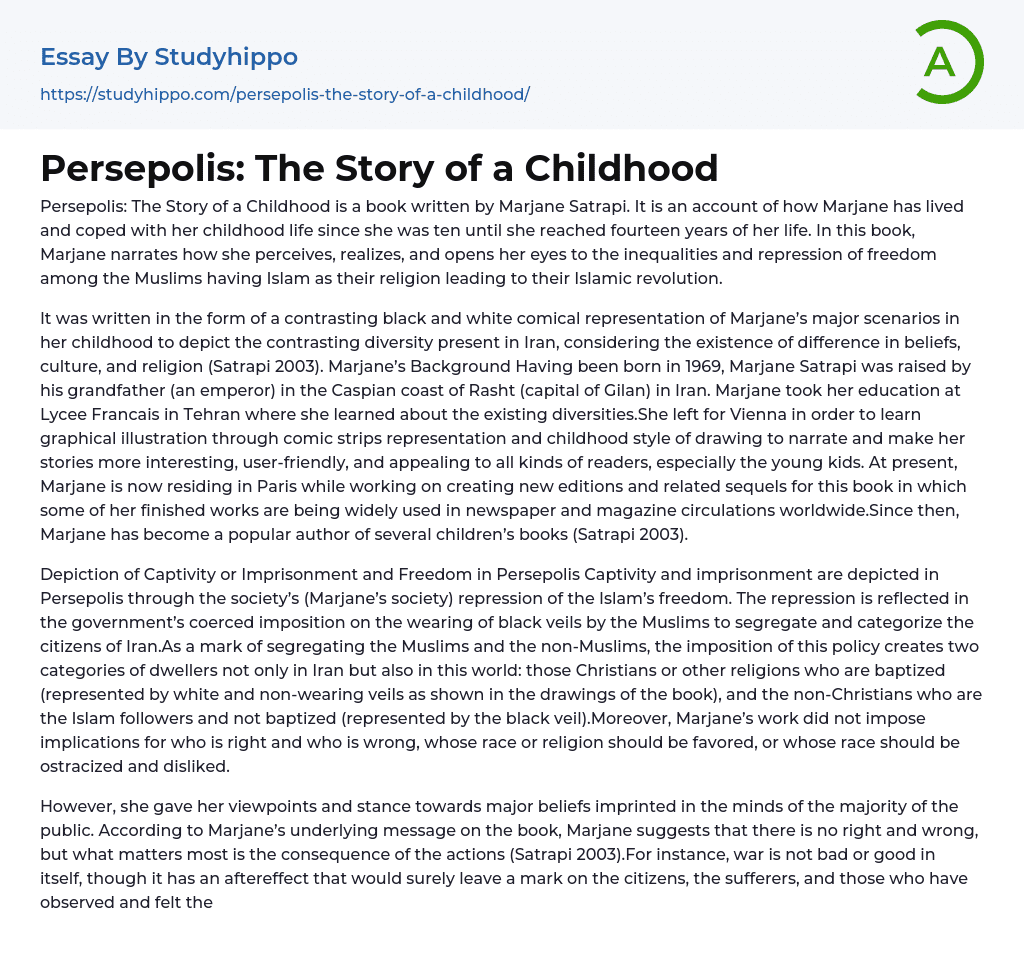Marjane Satrapi authored Persepolis: The Story of a Childhood, which recounts her experiences from ages ten to fourteen. The book explores how Marjane came to understand the injustices and limitations imposed on Muslims who adhere to Islam, ultimately leading to the Islamic revolution.
Marjane Satrapi used a black and white comical style to contrast the diversity in Iran, including differences in beliefs, culture, and religion (Satrapi 2003). Born in 1969, Marjane was raised by her grandfather (an emperor) in Rasht, Iran. She attended Lycee Francais in Tehran and was exposed to diversities. Marjane moved to Vienna to study graphical illustration using comic strips and childhood-style drawings that appeal to all readers, especially young children. Currently residing in Paris, she creates new editions and sequels for her book which are widely used in newspapers and magazines globally. Marjan
...e is also a popular author of children's books (Satrapi 2003).
The concept of captivity and freedom in Persepolis is illustrated by the suppression of Islam's liberty within Marjane's society. The government mandates that Muslims wear black veils as a means of segregating and classifying Iran's population, creating a divide between two groups: baptized non-Muslims (represented by white veils in the book) and non-Christian Muslims (represented by black veils). This policy results in social oppression not only in Iran but around the world. However, Marjane does not endorse any particular religion or ethnicity nor advocate for discrimination against any group.
In her 2003 book, Marjane argues that the outcome of actions is more important than a clear distinction between right and wrong. She uses war as an example, stating that it cannot be classified as good or bad, but its aftermath cause
emotional suffering for citizens, victims, and bystanders alike. The consequences of rebellion, oppression, and revolution can also have similar outcomes for minority groups like the Islamic race. Furthermore, Marjane discusses inequality by sharing her vision for a future where everyone is equal.
In her childhood, the protagonist aspires to be an optimistic prophet who can predict a better future for her society and lists three of her ideals: 1) Cadillacs should be accessible to everyone, not just her father; 2) maids should dine with masters; and 3) old people should not suffer. These ideals reflect the inequalities and captivity inflicted on Islamic culture. She questions the oblige of wearing a black veil and wonders why they cannot have the freedom to do what they desire. Marjane's artistic style subtly presents each scenario as an ideal and realization from a child's perspective. Satrapi's writing style objectively portrays the diversity in religion, culture, and beliefs of Muslim and non-Muslims.
Marjane Satrapi chose black and white for all the drawings in her book to emphasize the prevalent division of people. The discrimination between Muslims and their Islamic religion is clearly demonstrated through the creation of two categories: Muslims (white) and non-Muslims (black). The contrasting colors represent the yin and yang figure, symbolizing the good and bad, night and day, clean and dirty. This choice of styling adds to the visual effect of generalizing that there are two opposing elements in the entire story. Furthermore, Marjane's drawing style was intentionally childlike to create a humorous and comical effect that avoids presenting the oppression and cruelty of the subject matter in a straightforward manner.
Through her illustrations, Marjane was successful
in conveying her intended message and provided all readers with historical information to help them understand the present situation of Muslims. She makes it clear that Muslims did not want oppression, categorization, discrimination, or segregation; they wanted to live free and have rights to express their religion, leisure activities, and other fundamental freedoms.
According to Satrapi (2003), Marjane intentionally incorporates symbolic patterns in her drawings to enhance their power, meaning, and clarity. These patterns aim to stimulate the audience's creative and expressive minds while promoting awareness and understanding of the current situation of Muslims in Iran and around the world. The book is significant because it depicts a child's perspective on living in an oppressive society while maintaining an attitude of optimism and perseverance for her race. Satrapi emphasizes learning from history to avoid repeating past mistakes instead of blaming oppressors, encouraging individuals to take responsibility for their actions.
Marjane Satrapi's Persepolis: The Story of a Childhood offers a child's perspective on living with oppression and discrimination in society. Satrapi objectively portrays the inequalities and repressions faced by Muslims, emphasizing the importance of awareness regarding the consequences of actions. She suggests that while there is no right or wrong, Muslim repression ultimately harms both oppressor and oppressed, leading to separation, outrage, depression, frustration, and even war.
- Childhood Memory essays
- Quran essays
- Al-Qaeda essays
- Muhammad essays
- Muslim essays
- Ali essays
- Ramadan essays
- Adolescence essays
- Childhood essays
- Growth Mindset essays
- Individual essays
- Infant essays
- Is Google Making Us Stupid essays
- Egypt essays
- Iran essays
- Iraq essays
- Israel essays
- Saudi Arabia essays
- Syria essays
- Afterlife essays
- Atheism essays
- Bible essays
- Buddhism essays
- Christian Worldview essays
- Christianity essays
- Confession essays
- Cosmological Argument essays
- Deism essays
- Devil essays
- Existence of God essays
- Faith essays
- Freedom Of Religion essays
- God essays
- Hinduism essays
- Immortality essays
- Islam essays
- Jainism essays
- Jews essays
- Judaism essays
- Miracle essays
- Monk essays
- Monotheism essays
- New Testament essays
- Old Testament essays
- Pilgrimage essays
- Puritans essays
- Revelation essays
- Ritual essays
- Salvation essays
- Sin essays




